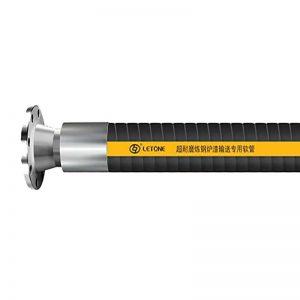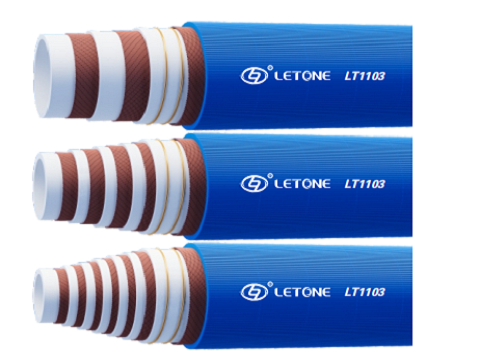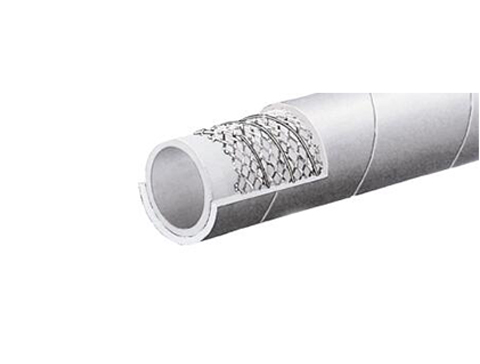In the vast field of industrial production and laboratory research, the importance of chemical conveying hoses as bridges connecting various equipment and storage tanks is self-evident. These hoses not only carry the safe transportation tasks of various chemicals, but also directly relate to multiple aspects such as production efficiency, personnel safety, and environmental protection. This article will delve into the basic characteristics, material selection, design considerations, usage and maintenance, as well as future development trends of chemical conveying hoses, in order to provide comprehensive and professional guidance for practitioners in related industries.
1、 Basic characteristics of chemical conveying hoses
Chemical conveying hoses need to have a series of unique properties to adapt to complex and changing working environments. Firstly, corrosion resistance is the primary consideration factor, as different chemicals may have strong acids, strong bases, organic solvents, and other characteristics, posing a severe challenge to hose materials. Secondly, the sealing performance is directly related to the risk of chemical leakage. Good sealing design can effectively prevent medium leakage, protect the environment and personnel safety. In addition, flexibility enables flexible installation of hoses in different spatial layouts, improving operational convenience; Wear resistance extends the service life of the hose and reduces the frequency of replacement. Finally, high or low temperature resistance is also an important characteristic for specific application environments.
 2、 Material selection
The material selection of chemical conveying hoses is a combination of science and art. Common hose materials include rubber (such as EPDM, NBR, PTFE, etc.), polyurethane (PU), polyvinyl chloride (PVC), fluororubber (FKM), as well as special alloys or composite materials. Each material has its unique chemical stability and physical properties, and selecting the appropriate material requires comprehensive consideration of the chemical's properties (such as pH, temperature, pressure, solubility, etc.), working environment (such as temperature, humidity, radiation, etc.), and cost-effectiveness. For example, PTFE (polytetrafluoroethylene) hoses are widely used in the transportation of highly corrosive chemicals due to their excellent corrosion resistance and high temperature stability; PVC hoses are widely used in general corrosive media and the food industry due to their low cost and easy processing.
3、 Design considerations
Designing an efficient and safe chemical delivery hose requires careful consideration from multiple dimensions. Firstly, the structural design includes the setting of reinforcement layers (such as steel wire weaving layers and fiber weaving layers) to enhance the pressure bearing capacity and burst resistance of the hose; Smooth inner wall to reduce fluid resistance and improve conveying efficiency; And the wear-resistant and weather resistant design of the outer coating. Next is the connection method, such as flange connection, threaded connection, quick connector, etc., which should ensure tight connection, easy disassembly and assembly, and not easy to leak. In addition, the establishment of an identification and traceability system is also crucial for users to identify hose types, specifications, production dates, and replacement cycles, achieving scientific management.
4、 Usage, Maintenance, and Safety Management
During the use of chemical conveying hoses, regular maintenance checks are required, including visual inspections (such as cracks, wear, deformation, etc.), pressure testing, sealing testing, etc., to ensure that the hoses are in good condition. At the same time, correct operation is the key to preventing accidents, such as avoiding excessive bending and twisting of hoses, controlling conveying pressure and flow rate, and preventing hoses from coming into contact with sharp objects. During storage and transportation, attention should also be paid to avoiding direct sunlight, high temperature baking, and direct contact with harmful chemicals. In addition, establishing a sound safety management system, strengthening personnel training, and enhancing safety awareness are important measures to ensure the safety of chemical transportation.
With the advancement of technology and rapid development of industry, the field of chemical conveying hoses is experiencing a series of innovations and changes. On the one hand, the research and application of new materials will continue to drive the improvement of hose performance, such as the introduction of nanomaterials and biobased materials, which are expected to bring higher corrosion resistance and lower environmental burden. On the other hand, the trend towards intelligence is becoming increasingly evident. For example, hoses with integrated sensor technology can monitor parameters such as pressure, temperature, and flow in real-time, enabling remote monitoring and early warning, and improving production efficiency and safety. In addition, the research and development of environmentally friendly hoses is also an important direction for future development, promoting the industry towards green and sustainable development by reducing the use of harmful substances and improving material recycling rates.
In summary, chemical conveying hoses are an indispensable part of industrial production and laboratory research, and their performance directly affects production safety, efficiency, and environmental protection.
2、 Material selection
The material selection of chemical conveying hoses is a combination of science and art. Common hose materials include rubber (such as EPDM, NBR, PTFE, etc.), polyurethane (PU), polyvinyl chloride (PVC), fluororubber (FKM), as well as special alloys or composite materials. Each material has its unique chemical stability and physical properties, and selecting the appropriate material requires comprehensive consideration of the chemical's properties (such as pH, temperature, pressure, solubility, etc.), working environment (such as temperature, humidity, radiation, etc.), and cost-effectiveness. For example, PTFE (polytetrafluoroethylene) hoses are widely used in the transportation of highly corrosive chemicals due to their excellent corrosion resistance and high temperature stability; PVC hoses are widely used in general corrosive media and the food industry due to their low cost and easy processing.
3、 Design considerations
Designing an efficient and safe chemical delivery hose requires careful consideration from multiple dimensions. Firstly, the structural design includes the setting of reinforcement layers (such as steel wire weaving layers and fiber weaving layers) to enhance the pressure bearing capacity and burst resistance of the hose; Smooth inner wall to reduce fluid resistance and improve conveying efficiency; And the wear-resistant and weather resistant design of the outer coating. Next is the connection method, such as flange connection, threaded connection, quick connector, etc., which should ensure tight connection, easy disassembly and assembly, and not easy to leak. In addition, the establishment of an identification and traceability system is also crucial for users to identify hose types, specifications, production dates, and replacement cycles, achieving scientific management.
4、 Usage, Maintenance, and Safety Management
During the use of chemical conveying hoses, regular maintenance checks are required, including visual inspections (such as cracks, wear, deformation, etc.), pressure testing, sealing testing, etc., to ensure that the hoses are in good condition. At the same time, correct operation is the key to preventing accidents, such as avoiding excessive bending and twisting of hoses, controlling conveying pressure and flow rate, and preventing hoses from coming into contact with sharp objects. During storage and transportation, attention should also be paid to avoiding direct sunlight, high temperature baking, and direct contact with harmful chemicals. In addition, establishing a sound safety management system, strengthening personnel training, and enhancing safety awareness are important measures to ensure the safety of chemical transportation.
With the advancement of technology and rapid development of industry, the field of chemical conveying hoses is experiencing a series of innovations and changes. On the one hand, the research and application of new materials will continue to drive the improvement of hose performance, such as the introduction of nanomaterials and biobased materials, which are expected to bring higher corrosion resistance and lower environmental burden. On the other hand, the trend towards intelligence is becoming increasingly evident. For example, hoses with integrated sensor technology can monitor parameters such as pressure, temperature, and flow in real-time, enabling remote monitoring and early warning, and improving production efficiency and safety. In addition, the research and development of environmentally friendly hoses is also an important direction for future development, promoting the industry towards green and sustainable development by reducing the use of harmful substances and improving material recycling rates.
In summary, chemical conveying hoses are an indispensable part of industrial production and laboratory research, and their performance directly affects production safety, efficiency, and environmental protection.







